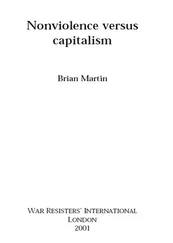The links between the military and the state also have implications for technology. A large proportion of funding for R&D comes from the state. This includes many nominally civilian areas, such as transport systems, communications, sewerage, energy and industry. Planners within the state are likely to prefer technological systems that ensure continuation of state power.
For example, central provision of energy, through oil and natural gas supplies and through electricity produced at large power stations, is ideally suited for allowing state control or regulation. Taxes can easily be imposed on such energy operations, since consumers must obtain their energy from a few large suppliers. Contrast this with a community in which building design eliminates the need for most energy for heating, town planning allows most people to walk or ride bicycles, and small local enterprises provide for energy from the sun, wind and biofuels. With such a community, there is much less need for strong state intervention. The energy system is low risk: there is no hazard from nuclear reactor accidents, large oil spills, or sabotage of electricity generating plants. There is less dependence on external supplies, and hence resource control — and struggles over this control — is not so vital an issue. There is no great need for heavy investment in automobile manufacture or freeway construction, and hence less need for central regulation or funding in these sorts of areas. Because the community is largely self-sufficient in energy, there is less justification for taxing the energy sector. [38] . Andreas Speck notes that an alternative interpretation is that centralised energy systems are more a result of capitalist interests, with big companies using their control to keep competitors small and dependent.
As will be discussed in chapter 6, the conventional high-energy-use system, with its high risks, high vulnerability to disruption and large economic investments, also makes it a target for military attack. Thus, military forces are needed to defend such a system. By contrast, the low-energy self-reliant system has much less need for military defence. [39] . A self-reliant system is much more useful in an actual war, since it cannot be destroyed as easily. The point here is that centralised systems, through their very vulnerability, provide a stronger justification for military defence.
This example shows the mutually consistent and reinforcing roles of the state and the military. The energy system that provides a convenient vehicle for state intervention and extraction of resources (taxes) for the state is also one that requires and justifies the military. Part of the state’s extraction of resources is to provide energy supplies for the military itself. Centralised provision of energy is convenient for this purpose. By contrast, a system built around energy efficiency, solar heaters and town planning to reduce transport doesn’t provide much scope for supporting an energy-hungry military.
From the point of view of the state, the traditional dichotomies between “peace” and “war” and between “civil” and “military” are increasingly irrelevant. The military capacity of a state depends on systems of education and training, R&D and industry, all ostensibly “civil” arenas. Especially since World War II, the states of industrial societies have pursued policies concerning knowledge and production that lay the basis for technological warfare. [40] . Maurice Pearton, The Knowledgeable State: Diplomacy, War and Technology since 1830 (London: Burnett Books, 1982).
Monopoly capitalism — built around large corporations with active intervention by the state in support of these corporations — favours technologies that also tend to be useful for the military. The automobile industry is an example. A transport system based on large production plants is relatively easy to adapt for military purposes. This is partly because the plants can be converted to produce military goods, but more because the plants are controlled by a few people through large corporate bureaucracies. This organisational structure is easily influenced to serve military ends, either through military contracts or through direct administration in wartime. [41] . For a nice treatment of different relationships between the state and war industry in the United States, see Gregory Hooks and Gregory McLauchlan, “The institutional foundations of warmaking: three eras of U.S. warmaking, 1939-1989,” Theory and Society , Vol. 21, 1992, pp. 757-788.
By contrast, a production system based on smaller enterprises producing more bicycles and fewer heavy vehicles, with a great deal of worker control, is less subject to central control either by capitalists or military administrators.
The economic system commonly called communism — but better described as state socialism, bureaucratic socialism or state capitalism — serves military imperatives even more directly and easily than monopoly capitalism. [42] . See for example Carl Gustav Jacobsen, “Arms Build-ups under Socialism: The USSR and China,” in N. P. Gleditsch and O. Njølstad, (eds.), Arms Races: Technological and Political Dynamics (London: Sage, 1990), pp. 285-294.
In the case of both capitalism and state socialism, the large scale of production, the role of the state in regulation and the system of bureaucratic management of enterprises all favour technological systems that are compatible with military purposes.
Similar considerations apply to the role of bureaucracy, which can be defined as a way of organising work built around the principle that workers are replaceable cogs. [43] . Fred Emery (personal communication) provided this convenient encapsulation of bureaucracy.
Bureaucracies are hierarchical, based on a division of labour and operate using standardised procedures. Most government bodies are organised as bureaucracies, but so are large corporations, political parties, churches, trade unions and many other organisations. The military is perhaps the ultimate in bureaucracies, with its rigid hierarchy (the ranks) and system of command. Bureaucracy is the basic organising principle of the state, monopoly capitalism and the military. The technological systems favoured by bureaucratic elites are ones that ensure them a continuing role and position of power. They tend to favour large systems requiring centralised control, such as centralised welfare systems and large hospitals. The previous examples of transport and energy illustrate the interests of bureaucratic elites.
Yet another important social structure linked to the military is patriarchy, the organised social domination of men over women. Patriarchy is a pervasive set of relationships, including male violence against women, control over reproductive choice, discrimination in employment, devaluation of child rearing, different social expectations for men and women, and many other dimensions. It is possible to argue that any system of unequal power, such as systems of central government and corporate management, are patriarchal in themselves; in any case, they are highly compatible with patriarchy, since men control most of the elite positions and regularly use their positions to maintain male privilege.
Militaries are notoriously patriarchal. [44] . Cynthia Enloe, Does Khaki Become You? The Militarisation of Women’s Lives (London: Pluto, 1983); Cynthia Enloe, The Morning After: Sexual Politics at the End of the Cold War (Berkeley: University of California Press, 1993); Betty Reardon, Sexism and the War System (New York: Teachers College Press, 1985); Jeanne Vickers, Women and War (London: Zed Books, 1993). On challenging this situation, see Birgit Brock-Utne, Educating for Peace: A Feminist Perspective (New York: Pergamon, 1985).
Most soldiers and almost all top commanders are men, and most military forces strongly denigrate human characteristics that are considered feminine. On the other hand, militaries are designed for fighting against other men. Women are victims, to be sure, both as civilian casualties and through being raped in wartime and within the military itself. But, it may be argued, the function of patriarchy is to allow some men to dominate other men (as well as women). If men are mobilised to defend male privilege and male identity against women, it becomes easier to maintain the role of elites (who are mostly men).
Читать дальше












